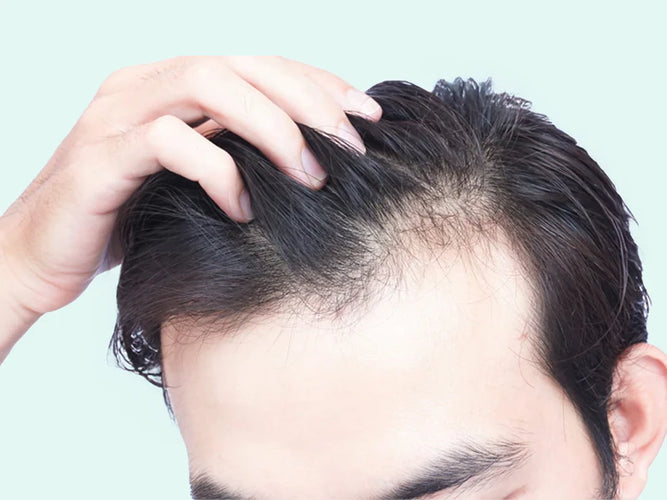Hereditary hair loss, also known as androgenetic alopecia, is the most common form of hair loss in both men and women. This type of hair loss develops gradually and usually follows a recognisable pattern. Although it is a natural process linked to genetic predisposition, it can have a significant impact on how you feel about yourself.
In this article, we explain what androgenetic alopecia is, how it develops, how to recognise it and what you can do to support your hair and scalp.
How does androgenetic alopecia develop?
Androgenetic alopecia results from a combination of genetic factors and hormonal influences. In people with hereditary sensitivity, the hair follicles respond more strongly to DHT, a natural hormone that plays a role in the normal hair growth cycle. When hair follicles are sensitive to DHT, the growth phase becomes shorter, and the hair that grows back is thinner, lighter and shorter.
This sensitivity is encoded in your DNA. Both men and women can inherit this tendency, although the way it shows differs between them. In men, the pattern is often clearly visible around the hairline or crown, while in women, there is usually a more general reduction in hair density.
Want to know more? Read our article about hair loss in men or hair loss in women.
It is important to remember that this is a gradual and natural process. It does not mean you are doing something wrong or that your scalp is unhealthy; it is simply a biological mechanism connected to hereditary traits of the hair follicles.
How to recognise hereditary hair loss in yourself
Hereditary hair loss develops slowly and can be recognised by a specific pattern that differs between men and women. In both cases, the first signs are usually thinning hair.
In men:
- The hairline gradually recedes at the temples or forehead.
- Hair on the crown begins to thin.
- Over time, these areas may merge, creating the familiar pattern of male baldness.
Want to learn more about how baldness develops in men? Read our article on the Norwood scale.
In women:
- Hair on the top of the head becomes gradually thinner.
- The parting may widen, or the scalp becomes more visible.
- The hairline usually remains intact.
- You may also notice that you lose more hair while brushing or washing, or that your hair is more difficult to style.
Would you like to read more about hair loss in women? Visit our article on the Ludwig scale.
Hereditary hair loss does not cause pain, redness or itching on the scalp. If itching or inflammation occurs, it may be due to another condition such as seborrhoeic dermatitis or dandruff.
Recognising these patterns can help you better understand what is happening, without assuming that something is medically wrong.
What can you do about hereditary hair loss?
Hereditary hair loss, or androgenetic alopecia, cannot be prevented, as it is part of your genetic make-up. However, you can slow the process and improve the condition of your hair and scalp. Maintaining a balanced lifestyle, gentle hair care and using routines that support the hair follicles can help keep the natural growth cycle active for longer.
It is not about curing hair loss but about maintaining and supporting healthy hair growth. Curious to know more about how to keep the natural growth process active for longer? Read our article about hair growth.
Frequently Asked Questions about androgenetic alopecia
At what age does hereditary baldness begin?
After puberty, testosterone levels rise, which means that slightly more DHT is produced. In men with a hereditary predisposition, the hair follicles overreact to this hormone. It is not because there is too much DHT, but because the follicles are more sensitive to it. As a result, the hair’s growth phase shortens, and hereditary hair loss can start at a young age.
In women, hereditary hair loss usually begins later in life, often around menopause. At that stage, oestrogen levels drop, and DHT has relatively more influence. Again, it is not the amount of DHT that matters but the sensitivity of the hair follicles, which leads to thinner hair mainly on the top of the head.
Are there factors that can worsen hereditary hair loss?
The sensitivity to DHT is hereditary, but certain factors such as stress, poor diet or harsh hair treatments can speed up the process. These factors do not cause androgenetic alopecia, but they can make the hair condition worse.
Does itching occur on bald patches with androgenetic alopecia?
Normally, no. Hereditary hair loss does not cause inflammation or itching. If your scalp does itch or flake, it might be due to another scalp condition such as seborrhoeic dermatitis or dandruff.
Can anything be done about sensitivity to DHT?
Sensitivity to DHT is hereditary and cannot be changed. However, caring for the scalp can help create a healthy environment for hair growth. Regular, gentle hair and scalp care can help maintain balance and support the natural hair growth process.
Conclusion
Androgenetic alopecia is a common form of hereditary hair loss that affects both men and women. It develops through a combination of genetic predisposition and hormonal influence and usually progresses gradually over many years. Although it cannot be completely prevented, you can contribute to a healthy foundation for your hair by maintaining gentle care and a balanced scalp.
Understanding what happens during hereditary hair loss can bring a sense of calm and clarity. It helps to set realistic expectations and to make conscious choices about how to care for your hair. Hereditary hair loss is not a fault of the body but a natural process that many people experience. With the right knowledge and care, you can give your hair and scalp the support they need.
Sources
Harvard Health Publishing – Understanding Hair Loss: Causes, Treatments, and Myths (2022)
A Randomized, Double‑Blind, Placebo‑Controlled Trial to Determine the Effectiveness of Botanically Derived Inhibitors of 5‑Alpha‑Reductase in the Treatment of Androgenetic Alopecia – (Prager N et al., 2002)
This information does not replace professional medical advice. If in doubt, always consult a doctor or specialist.













